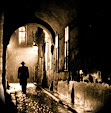
The Romans vs. Picts action thriller Centurion might seem like nothing more than B-movie schlock, but there’s no denying that it’s got a few things going for it. At the top of the list is its star Michael Fassbender, a promising actor who’s made a name for himself recently with roles in films like Inglorious Basterds, Fish Tank, and Hunger. It also doesn’t hurt that it was directed by Neil Marshall (Dog Soldiers, The Descent, Doomsday), the British horror auteur whose three previous films have shown him to be one of the few filmmakers around who actually respects and understands the history and fans of the genre. Throw in Olga Kurylenko as a mute warrior princess, the striking scenery of the Scottish highlands, and a little true history (the film is based on the legendary disappearance of Rome’s Ninth Legion), and there was a chance for Centurion to be memorable. But while Marshall’s hand for directing bone-crushing violence and tense chase scenes certainly doesn’t disappoint, the end product turns out to be the most generic genre exercise he’s attempted yet.
Fassbender stars as Quintus Dias, a Roman centurion serving in the legion during Hadrian’s ill-fated attempt to conquer the modern day United Kingdom. As the film opens, the takeover has turned into something of a quagmire, thanks to unforgiving weather and the presence of the Picts, a group of savage Celtic warriors who use guerilla tactics to repel all invaders. After their Ninth Legion is slaughtered in a surprise attack, Dias and a ragtag group of survivors take off across the countryside with a small war party led by the trident-carrying Etain (Kurylenko) on their trail.
This cat-and-mouse chase aspect of the film appears to have been the necessity of a small budget more than any kind of bold stylistic choice, and Marshall makes it work as best he can. He delivers on a few nice moments of tension, particularly a battle in the woods that leads to a Butch and Sundance nod where the characters are forced to jump off a cliff into a rushing river. Still, the attempt to make the small group of soldiers represent the entire strata of Roman society is hackneyed at best, and at its slower points the movie seems to be about nothing more than guys running through the woods with swords. A few attempts are made at building character—hell, they even introduce a beautiful witch living alone in the woods to add some sexual tension—but none of it ever amounts to more than the requisite pre-death talk of wives and future plans of starting farms and retiring from the soldier game. The striking scenery of the Scottish highlands is often the film’s saving grace, but beautiful as those hillsides may be, I eventually got tired of watching the characters sprint across them during long helicopter shots.
As it turns out, the film’s best moments all come early on, when Dias is still with the Ninth Legion and their charismatic leader, General Titus Virilius. As the General, Dominic West (probably known to most as McNulty from The Wire) steals every one of his scenes, and his presence in the film only succeeds in making it clear how uninteresting and incomplete a character Dias ultimately is. This portion of the movie also features the film’s best action scene, when the Ninth is ambushed on a forest road by an army of Picts. Marshall’s eye for carnage is spot on, but he tends to sacrifice coherence for gore a bit too often, to the point that the battle eventually degrades into one close up of a stabbing and throat slashing after another, with no real regard for continuity or the spatial positioning of any of the characters in the frame. That the blood is often CGI only adds to the confusion, as it has a tendency to make every action scene seem just a little too much like a video game. Still, no one could say Marshall doesn’t have a gift for portraying the brutality of ancient weapons, and throughout the film he continually ups the ante on creative ways for his characters to die by the sword.
Unfortunately, new and interesting uses of a trident can only carry a movie so far, and in the end Marshall fails to bring something new to this genre in the way he has with his other films. If anything, his big accomplishment here is that Centurion has none of the vaguely jingoistic underpinnings that taint so much (American) action cinema. Neither side—Picts or Romans—is presented as being morally superior to the other, and a bit of last minute double-dealing calls into question any easy ideas of heroism or victory. In Marshall’s world, there seems to be no constant righteousness or cause, and death only begets more death. That might not seem like much, but it’s pretty heavy territory for this kind of film to venture into, and hints at how Marshall just might be the next John Carpenter. Centurion, then, seems to be a sort of transitional film for him. Given more money for the production, it’s hard to say what kind of big budget madness he might have been able to concoct, and given less he probably would’ve spent a little more time building tension and writing decent character interaction. As it is, I can't help but think that Centurion had just enough of a budget to be mediocre.






















